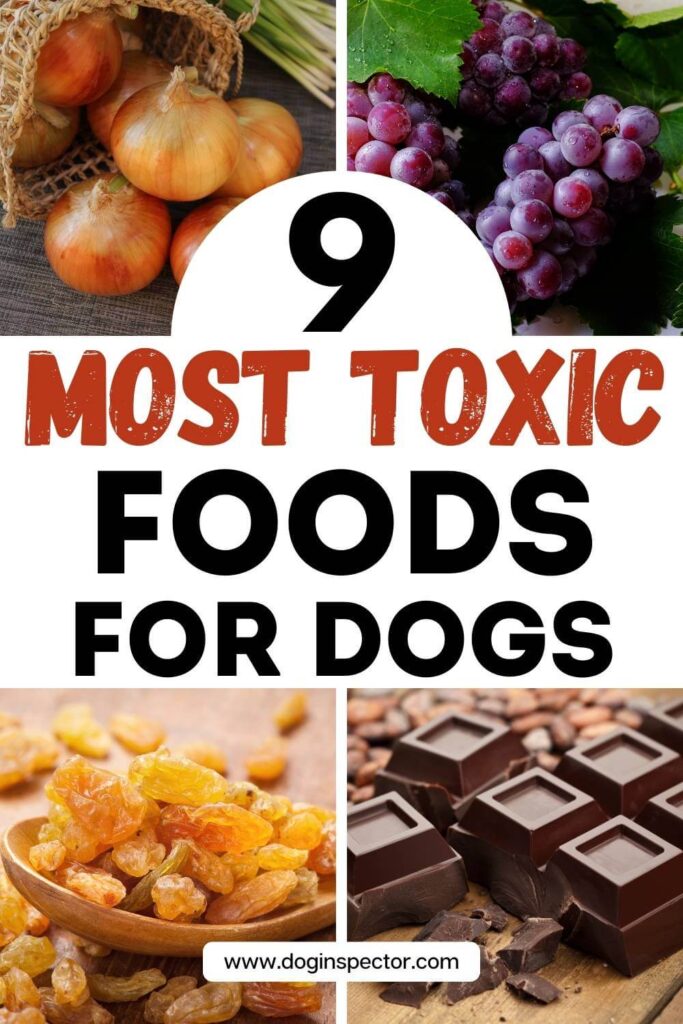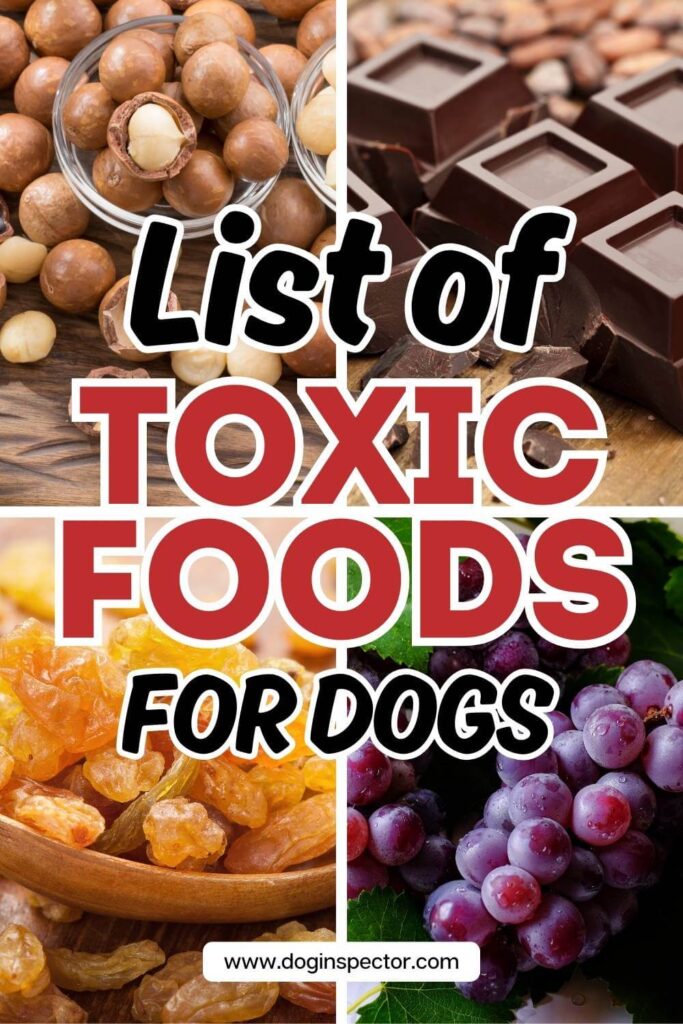9 Most Toxic Foods for Dogs
This post shows you the 9 Most Toxic Foods for Dogs!

We love our dogs and want to give them the world. Sharing food with them is one way we show love, but did you know that some human foods can be toxic to dogs?
While there are plenty of foods we can safely share, some can cause serious health problems—even in small amounts.
In this article, we’ll highlight 9 of the most toxic foods for dogs, why they’re dangerous, and how to keep your dog safe.

1 Chocolate
Chocolate is really one of the most toxic foods for dogs! While there’s no need to immediately panic if your dog eats a small piece, it’s crucial to know that dark chocolate is more toxic than milk chocolate, while white chocolate is not toxic at all.
Cocoa powder is also toxic to dogs, just like chocolate! Since both chocolate and cocoa contain theobromine, a substance that affects the heart, brain, and kidneys, it’s important to keep them out of your dog’s reach.
If your dog accidentally eats chocolate, don’t panic—try to figure out how much they ate. A small amount might not cause immediate issues, but you need to stay cautious.
- Why it’s toxic: Chocolate contains theobromine, which can harm the heart, brain, and kidneys.
- Reactions to eating: Vomiting, diarrhea, rapid breathing, seizures, or even death.
- What to do: Determine how much chocolate was eaten and check the wrapper to identify the type of chocolate. If symptoms appear or they ate too much, call your vet.
- Where to learn more: Learn about whether dogs can eat chocolate on Dog Inspector!
- Sources: Chocolate poisoning PMC article
2 Grapes and Raisins
Grapes and raisins are surprisingly toxic to dogs! Unlike chocolate, where the toxic component is known, it’s still unclear why grapes are one of the most dangerous foods for dogs.
The ASPCA published a study showing that grapes and raisins damage dogs’ kidneys and can cause anything from mild symptoms to complete kidney failure. The primary culprit is tartaric acid, a byproduct of grapes and wine. Dogs are sensitive to tartaric acid, so it’s not just grapes and raisins you need to watch out for—foods like cream of tartar used in baking can also be dangerous.
- Why they’re toxic: Grapes and raisins cause kidney damage and potential kidney failure in dogs. Their sensitivity to tartaric acid makes it impossible for them to break it down, disrupting waste filtration and fluid balance in their bodies.
- Reactions to eating: Vomiting, lethargy, and reduced appetite within hours.
- What to do: Estimate how much they ate and contact your vet immediately—grape and raisin toxicity can be fatal.
- Where to learn more: Learn about whether dogs can eat grapes and raisins.
- Sources: ASPCA on grape and raisin toxicity.
3 Xylitol
Xylitol, a popular sugar substitute in low-carb baking and sugar-free products, is extremely toxic to dogs. In fact, it’s one of the most dangerous substances for dogs, as it causes a rapid drop in blood sugar.
This drop, known as hypoglycemia, can lead to severe complications, including liver failure. Common sources of xylitol include sugar-free baked goods, protein treats, low-carb yogurts, and other zero-sugar or low-carb products. Always check ingredient labels to keep your dog safe.
- Why it’s toxic: Xylitol causes a rapid drop in blood sugar and can lead to liver failure.
- Reactions to eating: Vomiting, weakness, collapse, or seizures.
- What to do: Treat this as an emergency and contact your vet immediately.
- Where to learn more: FDA article about the dangers of xylitol.
- Sources: PubMed study on xylitol toxicity
4 Onions
Onions—and all types of onions, including spring onions and leeks—contain substances called sulfoxides and sulfides.
These substances aren’t harmful to us, but they make onions one of the most toxic foods for dogs. They damage dogs’ red blood cells and cause a condition called Heinz body anemia. When this happens, the red blood cells become so weak that they can’t carry oxygen throughout the body.
Here’s the tricky part: all forms of onions are dangerous. It doesn’t matter if they’re raw, cooked, powdered, or mixed into your leftovers or stir-fry.
Even small amounts of onion from a burger or onion rings your dog might sneak can be harmful. In fact, just 0.5% of your dog’s body weight in onion—whether eaten all at once or over a few days—can lead to serious health problems.
It’s even dangerous to cook with onions!
- Why they’re toxic: Onions have sulfoxides and sulfides that damage red blood cells and cause anemia.
- Reactions to eating: Weakness, lethargy, pale gums, and reduced appetite.
- What to do: It’s unlikely your dog will eat large amounts of onions, but if they do, try to figure out the amount and call your vet. Onion toxicity is rare, but you still need to be careful, especially with table scraps.
- Where to learn more: We wrote on Dog Inspector: Can Dogs Eat Onions?
- Sources: Onion toxicity to dogs PMC article
5 Garlic
Garlic is a bit less toxic to dogs compared to onions, but it’s more concentrated, making it really dangerous.
The biggest issue is that we often use highly concentrated garlic powder, which can cause even more severe problems.
Like onions, garlic contains compounds that damage dogs’ red blood cells. While a small amount of garlic from pasta or bread won’t harm your dog immediately, repeated exposure or larger doses can lead to serious health issues.
The toxic compounds in garlic are called organosulfur compounds. These create oxidants that attack red blood cells and interfere with hemoglobin, reducing the blood’s ability to deliver oxygen. This process ultimately leads to anemia.
- Why it’s toxic: Garlic contains compounds that damage red blood cells and hemoglobin, causing anemia.
- Reactions to eating: Weakness, lethargy, pale gums, and reduced appetite.
- What to do: Take your dog to the vet if they eat a lot of garlic or show symptoms.
- Where to learn more: I wrote in detail about—Can Dogs Eat Garlic!
- Sources: Allium species poisoning in dogs and cats
6 Alcohol
Alcohol is very toxic to dogs because they can’t process it the way people do. This is especially important to remember during holidays when rum- or brandy-filled candies are common.
Alcohol can cause vomiting, diarrhea, drops in blood sugar, and blood pressure, and it can also affect the brain.
- Why it’s toxic: Ethanol, the main toxin in alcohol, affects a dog’s central nervous system and lowers blood pressure and body temperature.
- Reactions to consuming: Vomiting, difficulty breathing, disorientation, or tremors.
- What to do: Call your vet or poison control right away if your dog consumes alcohol.
- Where to learn more: Animal Emergency Care on alcohol toxicity
- Sources: VCA article on alcohol poisoning
7 Macadamia Nuts
Macadamia nuts are classified as toxic to dogs, even though the exact reason and mechanisms are not really that clear.
According to the Merck Veterinary Manual, even 2.4 grams of macadamia nuts per kilogram of body weight can cause toxicity. Symptoms, including weakness, drowsiness, vomiting, and shaking, typically appear in a couple of hours but you can expect them within 12 hours of eating macadamia nuts. They can last up to 48 hours.
The good news is that macadamia nut toxicity is generally nonfatal. Still, it’s better to be safe and keep macadamia nuts out of reach.
- Why they’re toxic: The exact toxic compound is unknown, but macadamia nuts can cause neurological issues, weakness, and vomiting.
- Reactions to eating: Muscle tremors, vomiting, lethargy, or paralysis in severe cases.
- What to do: Contact your vet if your dog eats macadamia nuts.
- Where to learn more: Merck Veterinary Manual on macadamia nut toxicosis
- Sources: ASPCA on macadamia nuts
8 Raw Dough with Yeast
Raw dough is toxic to dogs because the yeast in their stomach continues to ferment. If a dog eats raw dough, it will expand in their stomach, causing extreme bloating and pressure.
Additionally, the fermentation process produces ethanol, leading to alcohol poisoning. Even though these cases are rare, it’s essential to monitor your dog closely if they ingest raw dough. Symptoms can include appearing drunk or unusually drowsy.
- Why it’s toxic: Yeast dough expands in the stomach, causing bloat, pain, and potentially dangerous alcohol production as it ferments.
- Reactions to eating: Abdominal swelling, vomiting, or lethargy.
- What to do: This is a medical emergency—contact your vet immediately.
- Where to learn more: I covered everything about raw dough in the article—Can Dogs Eat Bread
- Sources: Merck Veterinary Manual on bread dough toxicosis
9 Caffeine
Caffeine is very toxic to dogs because they can’t metabolize it effectively, similar to theobromine in chocolate.
Watch out for sugary iced coffees, tea, energy drinks, and even medications like cough syrups, as they may contain caffeine. It can cause panting, rapid breathing, increased heart rate, and tremors. Like humans, dogs can experience life-threatening complications from too much caffeine.
- Why it’s toxic: Caffeine overstimulates the heart and nervous system.
- Reactions to eating: Restlessness, rapid breathing, heart palpitations, or seizures.
- What to do: If your dog ingests caffeine, call your vet immediately.
- Where to learn more: ASPCA on foods to avoid
- Sources: VCA article on caffeine toxicity
In case you need emergency help with your dog, please call your vet (before you read stuff online), and if you’re in the US, contact the poison control center.
Pet Poison Control Centers
- Pet Poison Helpline, 855-764-661, http://www.petpoisonhelpline.com
- ASPCA Animal Poison Control Center, 888-426-4435, www.aspca.org/pet-care/animal-poison-control
Do you have more tips about any of these foods? Let us know in the comments!
Don’t forget to pin this post so you’ll always have this list of toxic foods for dogs handy!
Love, life, and fur forever!

This post showed you the 9 Most Toxic Foods for Dogs.
You may also like: